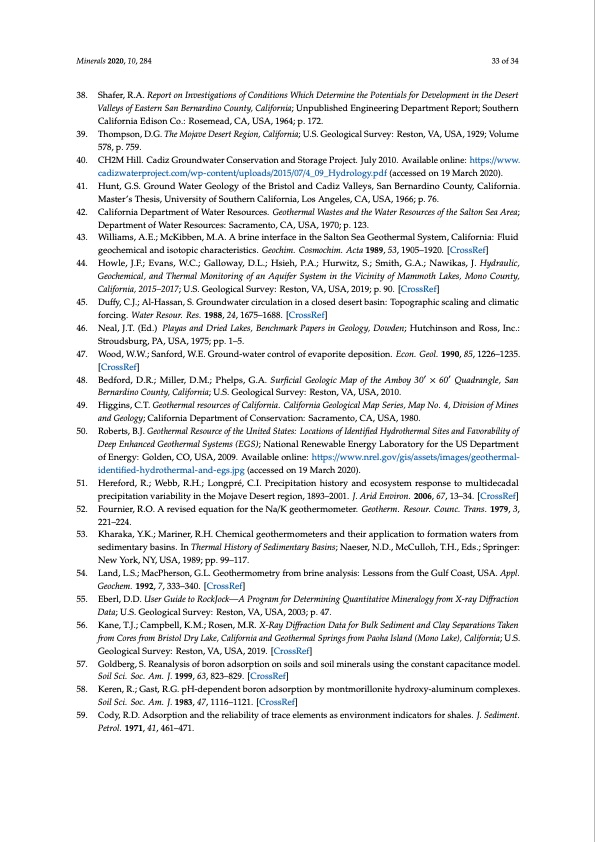
PDF Publication Title:
Text from PDF Page: 033
Minerals 2020, 10, 284 33 of 34 38. Shafer, R.A. Report on Investigations of Conditions Which Determine the Potentials for Development in the Desert Valleys of Eastern San Bernardino County, California; Unpublished Engineering Department Report; Southern California Edison Co.: Rosemead, CA, USA, 1964; p. 172. 39. Thompson, D.G. The Mojave Desert Region, California; U.S. Geological Survey: Reston, VA, USA, 1929; Volume 578, p. 759. 40. CH2M Hill. Cadiz Groundwater Conservation and Storage Project. July 2010. Available online: https://www. cadizwaterproject.com/wp-content/uploads/2015/07/4_09_Hydrology.pdf (accessed on 19 March 2020). 41. Hunt, G.S. Ground Water Geology of the Bristol and Cadiz Valleys, San Bernardino County, California. Master’s Thesis, University of Southern California, Los Angeles, CA, USA, 1966; p. 76. 42. California Department of Water Resources. Geothermal Wastes and the Water Resources of the Salton Sea Area; Department of Water Resources: Sacramento, CA, USA, 1970; p. 123. 43. Williams, A.E.; McKibben, M.A. A brine interface in the Salton Sea Geothermal System, California: Fluid geochemical and isotopic characteristics. Geochim. Cosmochim. Acta 1989, 53, 1905–1920. [CrossRef] 44. Howle, J.F.; Evans, W.C.; Galloway, D.L.; Hsieh, P.A.; Hurwitz, S.; Smith, G.A.; Nawikas, J. Hydraulic, Geochemical, and Thermal Monitoring of an Aquifer System in the Vicinity of Mammoth Lakes, Mono County, California, 2015–2017; U.S. Geological Survey: Reston, VA, USA, 2019; p. 90. [CrossRef] 45. Duffy, C.J.; Al-Hassan, S. Groundwater circulation in a closed desert basin: Topographic scaling and climatic forcing. Water Resour. Res. 1988, 24, 1675–1688. [CrossRef] 46. Neal, J.T. (Ed.) Playas and Dried Lakes, Benchmark Papers in Geology, Dowden; Hutchinson and Ross, Inc.: Stroudsburg, PA, USA, 1975; pp. 1–5. 47. Wood, W.W.; Sanford, W.E. Ground-water control of evaporite deposition. Econ. Geol. 1990, 85, 1226–1235. [CrossRef] 48. Bedford, D.R.; Miller, D.M.; Phelps, G.A. Surficial Geologic Map of the Amboy 30′ × 60′ Quadrangle, San Bernardino County, California; U.S. Geological Survey: Reston, VA, USA, 2010. 49. Higgins, C.T. Geothermal resources of California. California Geological Map Series, Map No. 4, Division of Mines and Geology; California Department of Conservation: Sacramento, CA, USA, 1980. 50. Roberts, B.J. Geothermal Resource of the United States: Locations of Identified Hydrothermal Sites and Favorability of Deep Enhanced Geothermal Systems (EGS); National Renewable Energy Laboratory for the US Department of Energy: Golden, CO, USA, 2009. Available online: https://www.nrel.gov/gis/assets/images/geothermal- identified-hydrothermal-and-egs.jpg (accessed on 19 March 2020). 51. Hereford, R.; Webb, R.H.; Longpré, C.I. Precipitation history and ecosystem response to multidecadal precipitation variability in the Mojave Desert region, 1893–2001. J. Arid Environ. 2006, 67, 13–34. [CrossRef] 52. Fournier, R.O. A revised equation for the Na/K geothermometer. Geotherm. Resour. Counc. Trans. 1979, 3, 221–224. 53. Kharaka, Y.K.; Mariner, R.H. Chemical geothermometers and their application to formation waters from sedimentary basins. In Thermal History of Sedimentary Basins; Naeser, N.D., McCulloh, T.H., Eds.; Springer: New York, NY, USA, 1989; pp. 99–117. 54. Land, L.S.; MacPherson, G.L. Geothermometry from brine analysis: Lessons from the Gulf Coast, USA. Appl. Geochem. 1992, 7, 333–340. [CrossRef] 55. Eberl, D.D. User Guide to RockJock—A Program for Determining Quantitative Mineralogy from X-ray Diffraction Data; U.S. Geological Survey: Reston, VA, USA, 2003; p. 47. 56. Kane, T.J.; Campbell, K.M.; Rosen, M.R. X-Ray Diffraction Data for Bulk Sediment and Clay Separations Taken from Cores from Bristol Dry Lake, California and Geothermal Springs from Paoha Island (Mono Lake), California; U.S. Geological Survey: Reston, VA, USA, 2019. [CrossRef] 57. Goldberg, S. Reanalysis of boron adsorption on soils and soil minerals using the constant capacitance model. Soil Sci. Soc. Am. J. 1999, 63, 823–829. [CrossRef] 58. Keren, R.; Gast, R.G. pH-dependent boron adsorption by montmorillonite hydroxy-aluminum complexes. Soil Sci. Soc. Am. J. 1983, 47, 1116–1121. [CrossRef] 59. Cody, R.D. Adsorption and the reliability of trace elements as environment indicators for shales. J. Sediment. Petrol. 1971, 41, 461–471.PDF Image | Bristol Dry Lake Brine Compared to Brines from Cadiz

PDF Search Title:
Bristol Dry Lake Brine Compared to Brines from CadizOriginal File Name Searched:
minerals-10-00284-v2.pdfDIY PDF Search: Google It | Yahoo | Bing
Product and Development Focus for Infinity Turbine
ORC Waste Heat Turbine and ORC System Build Plans: All turbine plans are $10,000 each. This allows you to build a system and then consider licensing for production after you have completed and tested a unit.Redox Flow Battery Technology: With the advent of the new USA tax credits for producing and selling batteries ($35/kW) we are focussing on a simple flow battery using shipping containers as the modular electrolyte storage units with tax credits up to $140,000 per system. Our main focus is on the salt battery. This battery can be used for both thermal and electrical storage applications. We call it the Cogeneration Battery or Cogen Battery. One project is converting salt (brine) based water conditioners to simultaneously produce power. In addition, there are many opportunities to extract Lithium from brine (salt lakes, groundwater, and producer water).Salt water or brine are huge sources for lithium. Most of the worlds lithium is acquired from a brine source. It's even in seawater in a low concentration. Brine is also a byproduct of huge powerplants, which can now use that as an electrolyte and a huge flow battery (which allows storage at the source).We welcome any business and equipment inquiries, as well as licensing our turbines for manufacturing.| CONTACT TEL: 608-238-6001 Email: greg@infinityturbine.com | RSS | AMP |